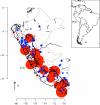Rubella metapopulation dynamics and importance of spatial coupling to the risk of congenital rubella syndrome in Peru
- PMID: 20659931
- PMCID: PMC3030822
- DOI: 10.1098/rsif.2010.0320
Rubella metapopulation dynamics and importance of spatial coupling to the risk of congenital rubella syndrome in Peru
Abstract
Rubella is generally a mild childhood disease, but infection during early pregnancy may cause spontaneous abortion or congenital rubella syndrome (CRS), which may entail a variety of birth defects. Consequently, understanding the age-structured dynamics of this infection has considerable public health value. Vaccination short of the threshold for local elimination of transmission will increase the average age of infection. Accordingly, the classic concern for this infection is the potential for vaccination to increase incidence in individuals of childbearing age. A neglected aspect of rubella dynamics is how age incidence patterns may be moulded by the spatial dynamics inherent to epidemic metapopulations. Here, we use a uniquely detailed dataset from Peru to explore the implications of this for the burden of CRS. Our results show that the risk of CRS may be particularly severe in small remote regions, a prediction at odds with expectations in the endemic situation, and with implications for the outcome of vaccination. This outcome results directly from the metapopulation context: specifically, extinction-re-colonization dynamics are crucial because they allow for significant leakage of susceptible individuals into the older age classes during inter-epidemic periods with the potential to increase CRS risk by as much as fivefold.
Figures






Similar articles
-
Implications of spatially heterogeneous vaccination coverage for the risk of congenital rubella syndrome in South Africa.J R Soc Interface. 2013 Jan 6;10(78):20120756. doi: 10.1098/rsif.2012.0756. J R Soc Interface. 2013. PMID: 23152104 Free PMC article.
-
Impact of birth rate, seasonality and transmission rate on minimum levels of coverage needed for rubella vaccination.Epidemiol Infect. 2012 Dec;140(12):2290-301. doi: 10.1017/S0950268812000131. Epub 2012 Feb 16. Epidemiol Infect. 2012. PMID: 22335852 Free PMC article.
-
Congenital rubella syndrome surveillance as a platform for surveillance of other congenital infections, Peru, 2004-2007.J Infect Dis. 2011 Sep 1;204 Suppl 2:S706-12. doi: 10.1093/infdis/jir407. J Infect Dis. 2011. PMID: 21954270
-
Congenital rubella syndrome: a matter of concern.Rev Panam Salud Publica. 2015 Mar;37(3):179-86. Rev Panam Salud Publica. 2015. PMID: 25988255 Review.
-
Burden of Congenital Rubella Syndrome (CRS) in Bangladesh: Systematic Review of Existing Literature and Transmission Modelling of Seroprevalence Studies.Infect Disord Drug Targets. 2020;20(3):284-290. doi: 10.2174/1871526518666181004092758. Infect Disord Drug Targets. 2020. PMID: 30289078
Cited by
-
Implications of spatially heterogeneous vaccination coverage for the risk of congenital rubella syndrome in South Africa.J R Soc Interface. 2013 Jan 6;10(78):20120756. doi: 10.1098/rsif.2012.0756. J R Soc Interface. 2013. PMID: 23152104 Free PMC article.
-
Phylogeography of rubella virus in Asia: Vaccination and demography shape synchronous outbreaks.Epidemics. 2019 Sep;28:100346. doi: 10.1016/j.epidem.2019.100346. Epub 2019 May 28. Epidemics. 2019. PMID: 31201039 Free PMC article.
-
Multinational patterns of seasonal asymmetry in human movement influence infectious disease dynamics.Nat Commun. 2017 Dec 12;8(1):2069. doi: 10.1038/s41467-017-02064-4. Nat Commun. 2017. PMID: 29234011 Free PMC article.
-
Rubella vaccination in India: identifying broad consequences of vaccine introduction and key knowledge gaps.Epidemiol Infect. 2018 Jan;146(1):65-77. doi: 10.1017/S0950268817002527. Epub 2017 Dec 4. Epidemiol Infect. 2018. PMID: 29198212 Free PMC article.
-
Global challenges and solutions to achieving and sustaining measles and rubella elimination.Rev Panam Salud Publica. 2024 Dec 16;48:e90. doi: 10.26633/RPSP.2024.90. eCollection 2024. Rev Panam Salud Publica. 2024. PMID: 39687257 Free PMC article.
References
-
- Anderson R. M., May R. M. 1991. Infectious diseases of humans. Oxford, UK: Oxford University Press
-
- Plotkin S. A. 2001. Rubella eradication. Vaccine 19, 3311–331910.1016/S0264-410X(01)00073-1 (doi:10.1016/S0264-410X(01)00073-1) - DOI - DOI - PubMed
-
- Banatvala J. E., Brown D. W. G. 2004. Rubella. Lancet 363, 1127–113710.1016/S0140-6736(04)15897-2 (doi:10.1016/S0140-6736(04)15897-2) - DOI - DOI - PubMed
-
- Best J. M. 2007. Rubella. Semin. Fetal Neonatal Med. 12, 182–19210.1016/j.siny.2007.01.017 (doi:10.1016/j.siny.2007.01.017) - DOI - DOI - PubMed
-
- Knox E. G. 1980. Strategy for rubella vaccination. Int. J. Epidemiol. 9, 13–2310.1093/ije/9.1.13 (doi:10.1093/ije/9.1.13) - DOI - DOI - PubMed
Publication types
MeSH terms
Grants and funding
LinkOut - more resources
Full Text Sources
Medical

